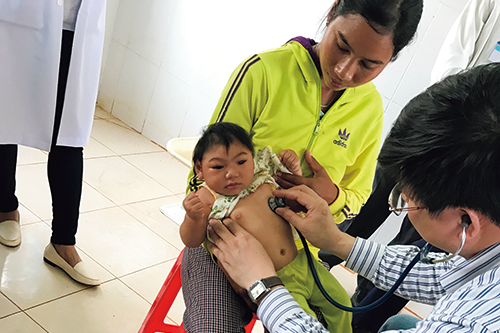Global Successes The Association Between Zika and Microcephaly in Vietnam
THE JAPAN INITIATIVE FOR GLOBAL RESEARCH NETWORK ON INFECTIOUS DISEASES (J-GRID)

In response to the worldwide threat posed by potential pandemic infectious diseases in Asia and Africa, AMED has been supporting J-GRID since 2015. The program encourages relationships with its nine collaborative research centers throughout Asia and Africa to promote the epidemiological research of infectious disease pathogens and explore new diagnostic systems, therapeutics and vaccines. Influenza, antimicrobial resistant strains, infectious diarrheal diseases and dengue fever are the current priority subjects of J-GRID, with studies taking place in areas directly affected by infectious diseases.
One such study, conducted by Dr. Hasebe and his team (Nagasaki University) in collaboration with the World Health Organization and National Institute of Hygiene and Epidemiology (NIHE), provided medical evidence to prove the link between the Zika virus and microcephaly in Vietnam.
Vietnam’s first case of Zika was discovered in March 2016 by Nagasaki University and the NIHE in Hanoi, when a Zika virus gene was detected in a test specimen and confirmed via sequence analysis.
However, due to the similarities between Zika and dengue fever, it was difficult to distinguish between the two viruses by using existing diagnostic methods. In response, two new tests were introduced by Nagasaki University: an in-house IgM ELISA assay and plaque reduction neutralization test (PRNT). The tests assisted in the discovery and confirmation of Zika cases in Vietnam – a total of 223 cases in less than one year.
In November 2016, researchers gathered serum from a newborn baby with microcephaly in the Dak Lak Province. Testing of the child, her immediate family and neighbors revealed high titers of Zika virus-specific neutralizing antibody, confirming recent viral exposure. An association between microcephaly and the Zika virus was then confirmed.
The study was the first of its kind in Asia to identify the risks of congenital Zika virus syndrome, proving the association of microcephaly with the disease through diagnostic data and highlighting the need for further investigation.
While its spectrum remains undefined, Dr. Hasebe and his team will strive to gain a better understanding of the virus and the infection prophylaxis in pregnant women throughout Asia.
 Concept
Concept
Utilize the plaque reduction neutralization test (PRNT) for the identification of the Zika virus infection in Vietnam. Discover Zika-associated microcephaly via PRNT.
 Progress
Progress
In March 2016, Vietnam’s first case of Zika was identified, and in August of the same year, the NIHE introduced PRNT to distinguish between dengue and Zika virus infection. Following its introduction, the first case of Zika virus associated microcephaly was detected in Vietnam.
 Collaborators
Collaborators
Nagasaki University; National Institute of Hygiene and Epidemiology (Vietnam); The World Health Organization
Last updated 09/20/18

